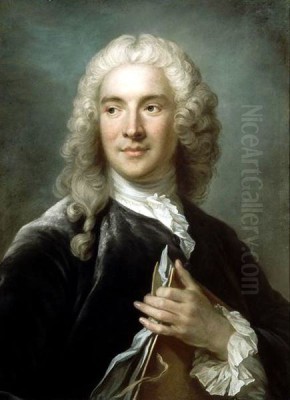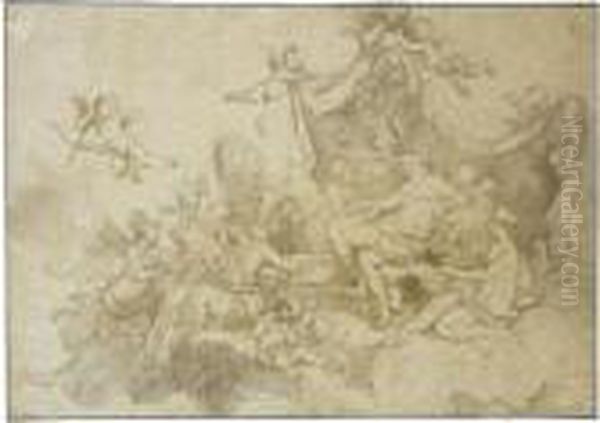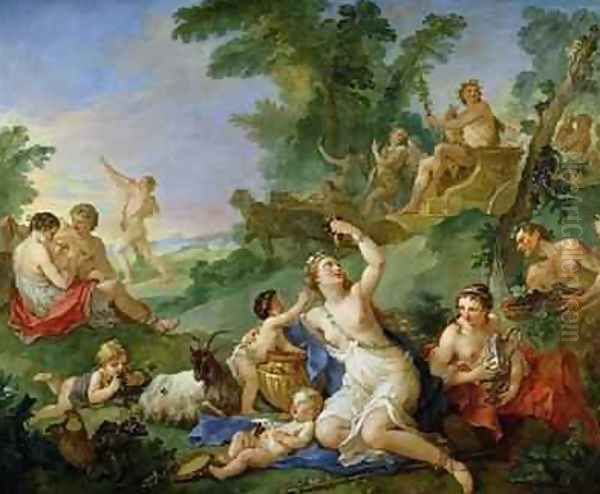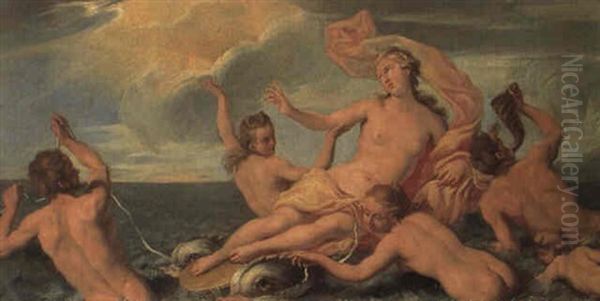
Charles-Joseph Natoire stands as a significant figure in the landscape of 18th-century French art. Born in Nîmes in 1700 and passing away in Castel Gandolfo, near Rome, in 1777, his life spanned a period of rich artistic development, particularly the flourishing of the Rococo style, of which he became a prominent exponent. Natoire was not only a prolific painter and decorator but also held the influential position of Director of the French Academy in Rome, shaping a generation of artists. His work, characterized by its elegance, vibrant colour, and mythological or historical themes, graced royal residences and important Parisian hôtels, leaving an indelible mark on the era's aesthetic.
Early Life and Artistic Formation
Natoire's journey into the art world began under the guidance of his own family. His father, Florent Natoire, was a sculptor and architect who recognized his son's burgeoning talent for drawing and painting early on. This familial encouragement was crucial, leading to the decision to send the young Charles-Joseph to Paris around the age of seventeen, approximately in 1717, to pursue formal artistic training. This move marked the beginning of a dedicated path towards a professional career in the arts.
In the bustling artistic center of Paris, Natoire first enrolled in the studio of Louis Galloche. Galloche, a respected history painter and member of the Royal Academy of Painting and Sculpture, provided Natoire with foundational training. After approximately three years under Galloche's tutelage, Natoire sought further refinement and moved to the workshop of François Lemoyne. Lemoyne was one of the leading painters of the day, celebrated for his large-scale decorative works and his role in defining the emerging Rococo style.

The period spent with Lemoyne proved particularly influential. Natoire absorbed his master's penchant for luminous colour palettes, dynamic compositions, and the graceful depiction of the human form, especially in mythological contexts. Lemoyne's style, itself influenced by Venetian masters and predecessors like Charles de La Fosse, deeply impacted Natoire's developing aesthetic. The relationship was strong enough that Natoire would later be involved in completing works left unfinished by Lemoyne. This rigorous training culminated in a major early success: winning the prestigious Prix de Rome in 1721, a prize awarded by the Royal Academy that funded study in Italy.
The First Roman Sojourn and Parisian Success
Winning the Prix de Rome was a pivotal moment, granting Natoire the opportunity to immerse himself in the artistic riches of Italy. He arrived at the French Academy in Rome around 1724, embarking on a period of intense study and artistic development that lasted until 1730. Rome offered direct exposure to the masterpieces of antiquity and the Italian Renaissance and Baroque periods, experiences that profoundly shaped his artistic vision. Artists like Raphael, Carracci, and Pietro da Cortona offered lessons in composition and grandeur.
During these years in Rome, Natoire honed his skills, particularly in drawing and composition. The provided texts suggest he developed a keen interest in landscape painting during this time, sketching the environs of Rome and Tivoli. This experience broadened his artistic repertoire beyond the history painting focus typical of Academy training. While specific interactions with Italian artists of the time aren't detailed in the provided snippets, the environment of the Academy fostered exchange among the French pensionnaires.
Upon his return to Paris in 1730, Natoire quickly established himself. He was accepted into the Royal Academy of Painting and Sculpture that same year and became a full academician in 1734. His talent attracted significant patronage, both royal and private. He received commissions to create decorative works for important locations, including the royal châteaux of Versailles, Fontainebleau, and Marly, as well as for the Abbey of Saint-Germain-des-Prés in Paris.
Major Commissions and Artistic Rivalry
The 1730s and 1740s were decades of significant achievement for Natoire. One of his most celebrated projects was the decoration of the Oval Salon in the Hôtel de Soubise in Paris (now part of the Archives Nationales). Here, he painted a series of eight canvases depicting the Story of Psyche, showcasing his mastery of the light, airy, and sensuous qualities of the Rococo style. This project placed him in direct collaboration, and sometimes friendly rivalry, with another giant of the Rococo era, François Boucher. Both artists contributed significantly to the hôtel's interiors, representing the pinnacle of French decorative painting at the time.

Natoire's reputation as a history painter also grew. In 1740, he received a commission for a series of paintings depicting the History of Mark Antony. This series included notable works such as The Entry of Mark Antony into Ephesus (completed 1741), Cleopatra Arrives at Tarsus (1756), and The Banquet of Cleopatra and Mark Antony (1754). These large-scale canvases demonstrated his ability to handle complex historical narratives with dramatic flair and rich detail, characteristic of the grand manner but infused with Rococo elegance.
His versatility extended to tapestry design. He created cartoons for the renowned Beauvais tapestry manufactory, most famously a series illustrating the History of Don Quixote. This project, undertaken later in his career, further cemented his position as a leading figure capable of working across different media and formats, adapting his style to the specific demands of tapestry weaving. His work was sought after by collectors and connoisseurs, reflecting his high standing in the Parisian art world alongside contemporaries like Carle Van Loo, Jean-Baptiste Oudry, and Jean-Marc Nattier.
Director of the French Academy in Rome
In 1751, Natoire reached the apex of his official career when he was appointed Director of the French Academy in Rome. This prestigious position placed him at the head of the institution where he himself had studied decades earlier. It marked a significant shift in his responsibilities, moving from primarily being a practicing artist to an administrator, educator, and representative of French artistic interests in Rome.
As Director, Natoire oversaw the training of young French artists who had won the Prix de Rome. Among the notable students or pensionnaires during his tenure were the landscape and ruins painter Hubert Robert and the celebrated Jean-Honoré Fragonard, whose later works would epitomize the late Rococo. Natoire continued the practice of encouraging landscape study, often taking students on sketching expeditions to sites like Tivoli, known for its picturesque gardens and ancient ruins. His own interest in landscape is reflected in works like Venus in the Garden, depicting the goddess bathing amidst the scenery of Tivoli. The sculptor Claude Michel, known as Clodion, also studied in Rome during Natoire's directorship, benefiting from the Academy's environment.

Despite his administrative duties, Natoire did undertake some significant artistic projects during his directorship. Perhaps the most important was the ceiling fresco depicting The Apotheosis of Saint Louis for the Church of San Luigi dei Francesi, the French national church in Rome. This work demonstrated his continued ability to execute large-scale religious commissions in a grand, albeit Rococo-inflected, style. Other works from this period include Orpheus Charming the Nymphs, Dryads, and Animals (1757), a highly finished drawing showcasing his technical virtuosity with multiple media like pen, ink, wash, chalk, and pastel.
However, his tenure as Director was not without difficulties. The provided texts mention criticisms regarding mismanagement of the Academy and accusations of religious intolerance or bigotry. Furthermore, a specific incident involving the prominent architect Victor Louis led to a social scandal, described as a breach of etiquette, which likely impacted Natoire's standing within the Franco-Roman community. These issues ultimately contributed to his dismissal from the post in 1775, after nearly a quarter-century of service.
Artistic Style and Techniques
Charles-Joseph Natoire's art is firmly rooted in the French Rococo style. His work embodies many of the movement's key characteristics: a preference for light, pastel colour palettes, dynamic and often asymmetrical compositions, graceful and elongated figures, and themes drawn from mythology, allegory, and history, often treated with a sense of lightness and charm. His style evolved from the influence of his teacher François Lemoyne, sharing a similar luminosity and decorative sensibility, but Natoire developed his own distinct manner.
He was highly skilled in depicting the human form, particularly the nude, as seen in works like The Rebuke of Adam and Eve (1740). This painting, created as an homage to Lemoyne, showcases his ability to render flesh tones and anatomy with sensuous elegance. His mythological scenes, such as the Psyche cycle for the Hôtel de Soubise, are filled with playful putti, flowing drapery, and idealized figures set within airy, idyllic landscapes.
Natoire was a versatile artist, comfortable working in various formats and genres. Beyond large-scale history paintings and decorative cycles, he produced portraits and religious works. His drawings were particularly admired, revealing his confident draughtsmanship and sensitivity to line and tone. As evidenced by the materials listed for the Orpheus drawing (pen, brown ink, grey and brown wash, pastel, blue and black chalk), he masterfully combined different media to achieve rich textural effects. His interest in landscape, particularly evident during his time in Rome, added another dimension to his oeuvre, capturing the light and atmosphere of the Italian countryside. His style can be situated alongside other Rococo masters like Boucher, Antoine Watteau, Nicolas Lancret, and Jean Restout II, each contributing uniquely to the era's dominant aesthetic.
Later Years, Legacy, and Unanswered Questions
After his dismissal as Director of the French Academy in Rome in 1775, Natoire remained in Italy. He passed away two years later, in 1777, at Castel Gandolfo. The provided texts hint at a certain melancholy in his later years. Despite his professional success, his personal life may have had its shadows, with suggestions of strained relationships with his siblings and a sense of loneliness during his long tenure in Rome, even when encountering old acquaintances.
Following his death, Natoire's estate was auctioned in Paris. The sale included numerous works, some unsigned, which required later scholarly efforts for proper attribution. This highlights his prolific output but also the complexities of connoisseurship regarding artists of this period. While highly regarded during his lifetime, the appreciation of his work may have fluctuated, particularly as artistic tastes began to shift towards Neoclassicism in the later 18th century, championed by artists like Jacques-Louis David and Joseph-Marie Vien, who represented a reaction against the perceived frivolity of the Rococo.
Nevertheless, Charles-Joseph Natoire's legacy is significant. He was a central figure in French Rococo painting and decoration, contributing major works to royal and aristocratic settings. His long tenure as Director of the French Academy in Rome placed him in a position of considerable influence, shaping the next generation of artists, including figures like Fragonard and Robert who would achieve great fame. His paintings and drawings continue to be studied and admired for their technical skill, elegant compositions, and embodiment of the Rococo spirit. He remains an essential artist for understanding the richness and complexity of French art in the age of Louis XV. His life, marked by both great success and later difficulties, offers a fascinating glimpse into the world of an 18th-century European artist navigating the demands of patronage, academic institutions, and evolving artistic tastes.